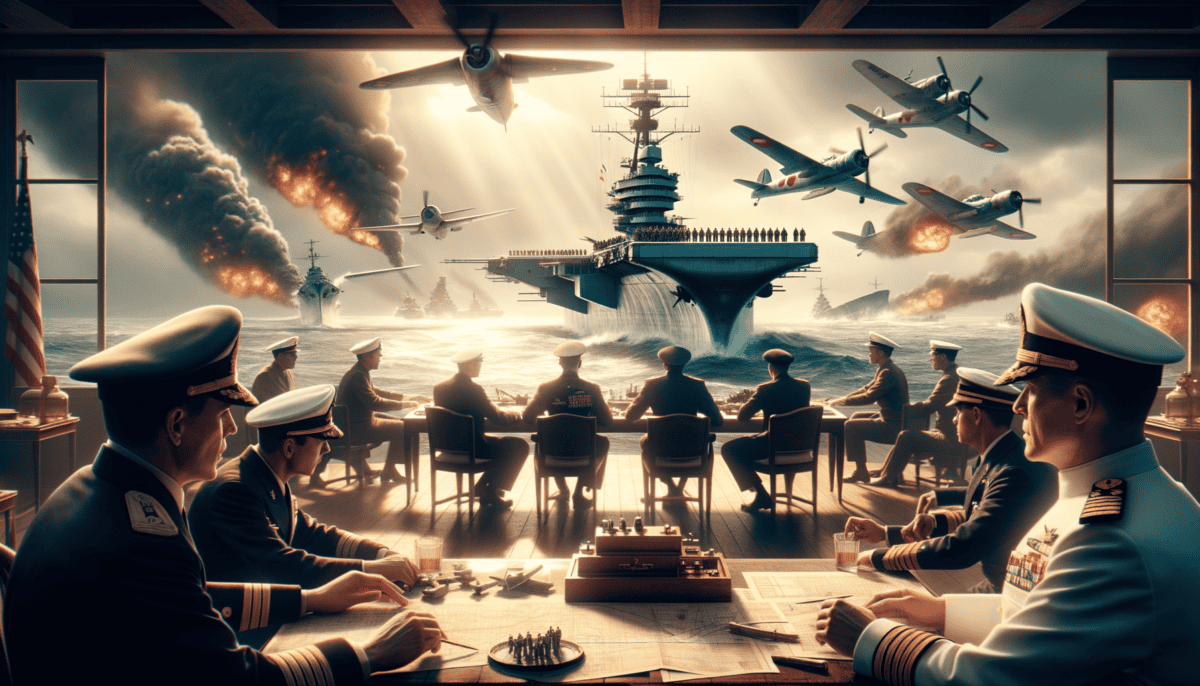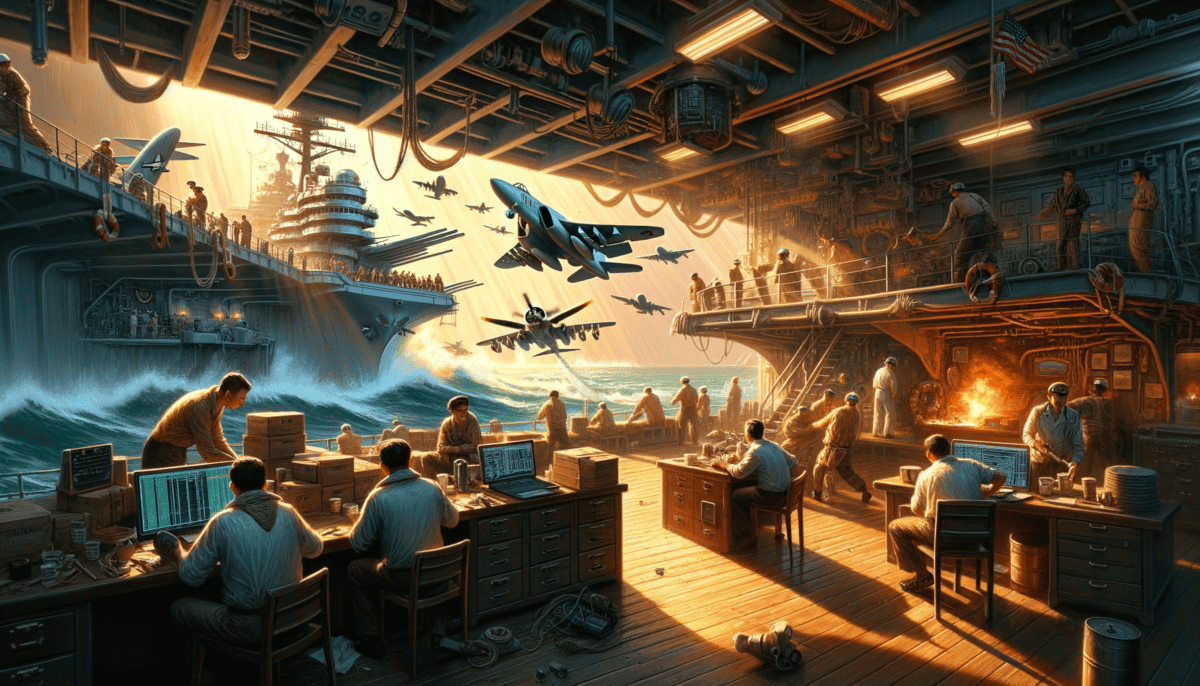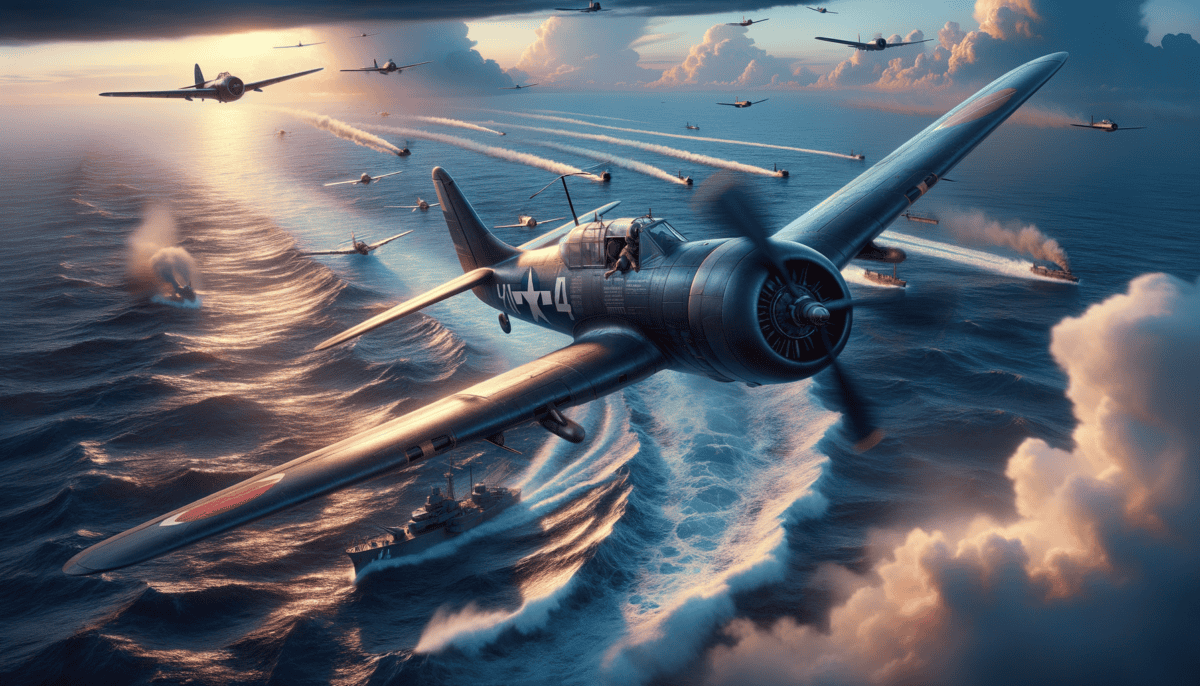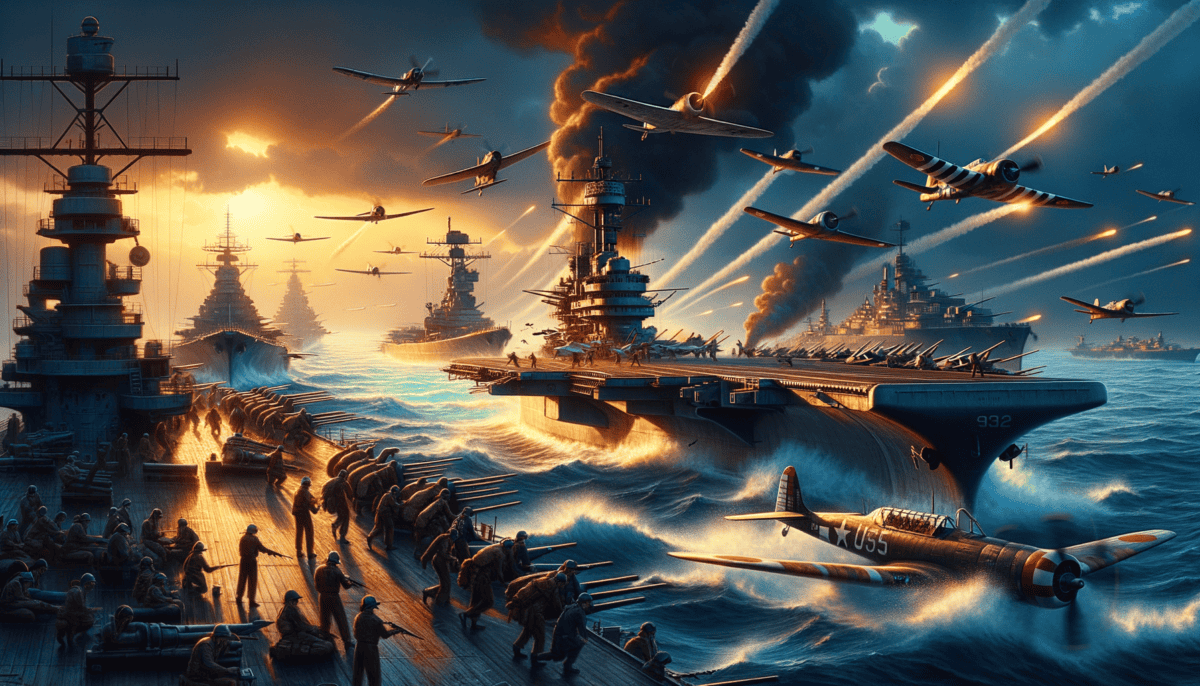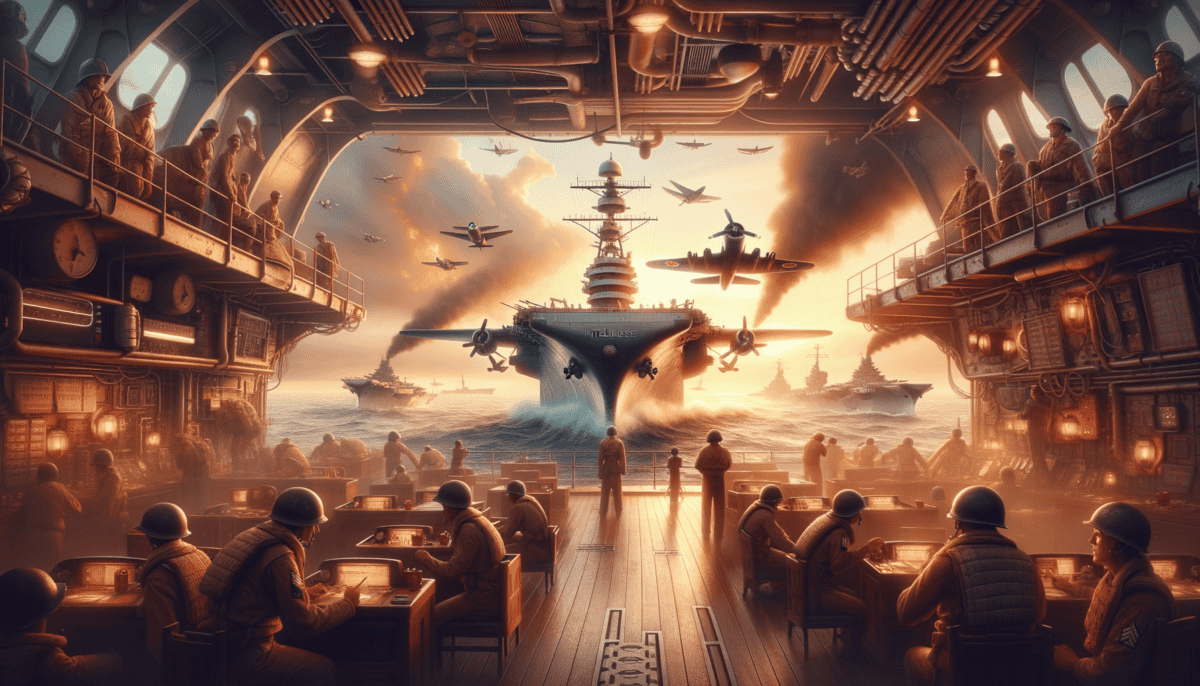Shadows and Secrets
The warm Hawaiian sun was setting over Pearl Harbor as Commander Joseph Rochefort rubbed his tired eyes. He sat at his desk in the basement of the Pacific Fleet headquarters, surrounded by stacks of papers covered in strange symbols. This secret room was called "Station HYPO" – a place where some of America's smartest code breakers worked day and night.
"I think I've got something!" called out Lieutenant James Harper, one of Rochefort's youngest team members. His voice echoed off the concrete walls.
Commander Rochefort hurried over, his coffee cup forgotten on his desk. The room was cool and dim, lit by desk lamps that cast long shadows. The only sounds were the whirring of fans and the scratching of pencils.
"Show me," Rochefort said quietly, leaning over Harper's shoulder.
On the desk lay rows of intercepted Japanese messages. To most people, they looked like random letters and numbers. But to these code breakers, they held important secrets.
Code breakers are like puzzle solvers who figure out secret messages.
"The Japanese keep talking about 'AF' in their messages," Harper explained, pointing to the papers. "They mention it over and over."
Rochefort nodded slowly. He hadn't slept much in days, staying up late trying to crack these codes. He wore his favorite bathrobe over his uniform – it helped him think better.
"But what is AF?" asked Sally Thompson, another code breaker. She pushed her glasses up her nose as she looked at the messages.
Rochefort paced the room, thinking hard. "What if… what if AF is a place?" he said. "Maybe it's Midway Island?"
The team got excited. They had to be sure. Rochefort came up with a clever plan. He asked the Americans on Midway to send a message saying their water machine was broken.
Then they waited.
Two days later, they intercepted a Japanese message: "AF is short on water."
"That's it!" Rochefort shouted, jumping up from his desk. "AF is Midway Island! The Japanese are planning to attack it!"
The room burst into activity. This was huge news that could help America win the war.
These are the key things the code breakers discovered:
- The Japanese would attack Midway Island
- They would use many ships and planes
- The attack would happen in early June
- They thought they could surprise America
Rochefort rushed to tell Admiral Nimitz the news. As he climbed the stairs from his basement office, his heart was racing. He knew this information could change everything.
"We did it," he whispered to himself. "We cracked their code."
The sun had fully set now, and stars twinkled over Pearl Harbor. In the dark basement office, the code breakers kept working. They knew more Japanese messages would come, and America needed to know what they said.
Little did the Japanese know, their biggest secret was no longer a secret at all. Thanks to Rochefort and his team of code breakers, America would be ready and waiting.
The Emperor’s Great Plan
Admiral Isoroku Yamamoto stood on the bridge of his flagship, the Yamato, watching the sunrise over Japan’s mighty fleet. His dark eyes scanned the dozens of warships stretching across the horizon.
“This will be our greatest victory,” he said softly to Captain Genda beside him. “The Americans will never expect us.”
The massive Japanese fleet was preparing for what they believed would be their biggest battle yet. Ships of all sizes filled the harbor, their crews busy loading supplies and checking equipment.
The Japanese fleet had more than 200 ships – that’s like filling a whole bay with boats!
“Tell me the plan again, Captain,” Yamamoto said, though he knew every detail by heart.
Captain Genda pulled out a simple map. “We will send our ships here, to Midway Island,” he explained, pointing to a tiny dot in the ocean. “The Americans will try to protect it. When they come, our ships will be waiting to surprise them!”
Yamamoto nodded, but something worried him. He remembered Pearl Harbor and how that attack had made America very angry. Still, he had to follow the Emperor’s orders.
“Our aircraft carriers are the key,” Captain Genda continued excitedly. “We have four of our best: the Akagi, Kaga, Soryu, and Hiryu. Their planes will attack Midway first.”
The Admiral watched young sailors running across the deck, getting ready for the long journey ahead. Many had never been in a big battle before.
“Remember, Captain,” Yamamoto said quietly, “America is like a sleeping giant. We must be very careful.”
That afternoon, Yamamoto called all his commanders together. The room was packed with Japan’s best naval officers, all wearing crisp uniforms with shiny medals.
“The Emperor himself has approved our plan,” Yamamoto announced. “We leave tomorrow at dawn.”
The commanders bowed deeply. None of them doubted they would win. They thought America was still weak from Pearl Harbor.
As night fell, Yamamoto stood alone on the deck. Stars reflected in the dark water below. He took out his old pocket watch, a gift from his time studying in America.
“Six minutes,” he whispered to himself. “That’s all we had at Pearl Harbor. But this time we need total victory.”
The next morning, fog covered the harbor as hundreds of ships began to move. Their engines rumbled like thunder. Thousands of sailors stood at attention as the massive fleet headed out to sea.
On the Akagi’s deck, pilots checked their planes one last time. They patted the zeros’ wings for good luck. These pilots were some of Japan’s best, but even they didn’t know the Americans had already cracked their secret code.
As his flagship led the fleet into open water, Admiral Yamamoto wrote in his diary: “Would America fight the way we expect? Or do they have a surprise waiting for us?”
The great Japanese fleet disappeared into the misty horizon. They were sailing toward Midway Island – and toward one of the biggest naval battles in history.
Far away in Pearl Harbor, Commander Rochefort’s code breakers were still hard at work, reading every message the Japanese sent. America knew they were coming, and they would be ready.
Racing Against Time
Admiral Chester Nimitz paced across his office at Pearl Harbor, his face deep in thought. The morning sun streamed through the windows, casting long shadows across the wall maps.
“Show me what we have,” he said to his officers gathered around a large table.
Commander John Ford spread out a simple chart. “We have three aircraft carriers, sir. The Enterprise, Hornet, and Yorktown. The Yorktown is hurt from our last battle, but she’s tough.”
“Three carriers against Japan’s four,” Nimitz said softly. “We’ll need more than luck to win this one.”
Down at the docks, hundreds of sailors and mechanics worked day and night to fix the Yorktown. The giant ship had been badly damaged in the Coral Sea battle just weeks before.
Workers fixed the Yorktown in just 3 days – a job that usually took months!
Young pilots practiced takeoffs and landings on the carrier decks. Many had never flown in battle before. Their commanding officer watched them with worried eyes.
“How are the new pilots doing?” Nimitz asked during his afternoon inspection.
“They’re learning fast, Admiral,” the flight instructor replied. “But the Japanese pilots have more experience.”
At sunset, Nimitz called his main commanders to a secret meeting. The room was quiet as he pointed to Midway Island on the big map.
“This tiny island is the key,” he explained. “We know the Japanese are coming to attack it. Thanks to our code breakers, we’ll be waiting for them.”
The commanders looked at each other nervously. Could they really trust the information from Rochefort’s team?
“Sir,” one officer spoke up, “what if we’re wrong? What if we send our ships to Midway and the Japanese attack somewhere else?”
Nimitz smiled confidently. “Sometimes you have to trust your gut. And right now, my gut says Rochefort is right.”
That night, as the carriers prepared to sail, Nimitz wrote a special message to every sailor and pilot:
“You are about to fight in one of the most important battles of this war. America is counting on you. Remember your training, watch out for each other, and never give up.”
The next morning, the American fleet left Pearl Harbor in complete silence. No bands played, no families waved goodbye. Everything was secret.
On the Enterprise’s deck, pilots named Dick Best and Wade McClusky checked their dive bombers. They knew the next few days would test everything they had learned.
“Ready for this?” Best asked his friend.
“Ready as I’ll ever be,” McClusky replied with a nervous smile.
As the ships moved into position near Midway, everyone felt the tension growing. They knew the Japanese were coming with more ships, more planes, and more experienced crews.
Admiral Nimitz stood on his flagship’s bridge, watching the horizon. The fate of the Pacific war might depend on what happened in the next few days. He touched the small cross he wore around his neck and whispered a quiet prayer.
The pieces were set. Now they just had to wait.
First Strike
The morning sun was just peeking over the horizon when the first alarm rang out. Lieutenant Jim Peterson jumped from his bunk on Midway Island, his heart racing.
“Radar contact!” shouted the watch officer. “Many planes coming from the north!”
The peaceful morning erupted into action. Sirens wailed across the tiny island as pilots ran to their planes. Within minutes, the sky filled with the roar of engines.
“This is it, boys!” called out Squadron Leader John Smith. “Remember your training!”
High above the ocean, American pilot Billy Mitchell spotted the first wave of Japanese planes. His hands gripped the controls of his fighter plane tightly.
The morning sky was clear and blue, perfect for spotting enemy planes.
“Enemy aircraft at twelve o’clock!” Billy’s voice crackled over the radio. “There must be hundreds of them!”
The first battle was fierce and fast. American fighters swooped down to meet the Japanese planes. The sky filled with smoke and the sound of guns.
Meanwhile, out at sea, Admiral Nagumo of Japan felt confident. He didn’t know the Americans were waiting for him. On his flagship carrier, he received news that surprised him.
“Sir!” his officer reported. “Midway’s defenses are stronger than we expected!”
Nagumo frowned. Something wasn’t right. He ordered his crews to switch the bombs on his planes – a decision he would soon regret.
Far away, on the USS Enterprise, Wade McClusky led his dive bombers into the sky. They had been searching for hours, and fuel was getting low.
“Look!” shouted his wingman. “A lone Japanese ship heading north!”
McClusky made a quick decision. He would follow that ship, hoping it would lead to the Japanese carriers. It was a choice that would change history.
At that same moment, Dick Best and his squadron spotted something amazing through a break in the clouds – the Japanese carrier fleet!
“There they are!” Best radioed excitedly. “Four carriers, just like intelligence said!”
The Japanese lookouts finally spotted the American planes, but it was too late. The dive bombers were already starting their attack runs.
“Remember what we practiced,” Best told his pilots. “Steep dive, steady aim, release bombs, pull up hard!”
The next few minutes were filled with incredible bravery. American pilots dove through heavy anti-aircraft fire, aiming for the Japanese carriers.
The Japanese sailors watched in horror as bombs struck their ships. Explosions rocked the massive carriers, and fires spread quickly across their wooden decks.
Within just five minutes, three Japanese carriers were hit and burning.
Back on the Enterprise, Admiral Spruance received the news with quiet satisfaction. The risk had paid off. The American pilots had struck a devastating blow.
“Sir,” reported his communications officer, “Our pilots say the Japanese carriers are burning!”
Young Billy Mitchell, who had survived the morning’s fighting, watched from his fighter as black smoke rose from the Japanese ships.
“I can’t believe we did it,” he whispered to himself.
But the battle wasn’t over yet. The surviving Japanese planes still filled the skies, and more fighting lay ahead. The next few hours would determine who would control the Pacific Ocean.
Victory at Sea
Thick black smoke rose from the Japanese carriers, turning the bright morning sky dark. ️ On the deck of the USS Enterprise, sailors watched in amazement.
“Three carriers hit!” the radio crackled with excited voices. “The Akagi, Kaga, and Soryu are burning!”
In just minutes, Japan’s mighty fleet had lost most of its striking power.
Admiral Yamamoto stood on his flagship’s bridge, his face grim. His perfect plan was falling apart. The proud Japanese carriers that had attacked Pearl Harbor were now wrapped in flames.
“How did the Americans know where to find us?” he wondered aloud.
Young Billy Mitchell flew his fighter plane above the chaos. Below him, Japanese sailors jumped into the ocean as their ships burned. He felt both sad and proud – sad for the loss of life, but proud that America was winning.
“Look!” his wingman called out. “The Hiryu is trying to escape!”
The last Japanese carrier, Hiryu, was turning north, trying to hide in a rain squall. But American planes were already on their way.
Wade McClusky, low on fuel but high on determination, led another attack. “We can’t let that last carrier get away!” he told his pilots.
The Hiryu’s deck was busy with activity. Japanese crews rushed to launch their remaining planes. They wanted one last chance to strike back.
“Enemy aircraft approaching!” shouted a Japanese lookout.
American bombs found their mark again. The Hiryu soon joined its sister ships, burning and sinking in the vast Pacific Ocean.
All four Japanese carriers were destroyed in just one day.
Back on Midway Island, tired pilots landed their planes. Ground crews rushed to help them, cheering and patting them on the back.
“Did you hear?” a mechanic shouted. “We got all their carriers!”
Admiral Nimitz received the news in Pearl Harbor. He smiled, knowing this battle would change everything. America was no longer on the defense – now they could fight back.
“Send this message to all ships,” he ordered. “Well done. The tide has turned.”
On the Japanese ships that were still floating, Admiral Yamamoto made a hard choice. He had to save what was left of his fleet.
“Signal all ships,” he commanded quietly. “We are returning to Japan.”
As the sun set on June 4, 1942, the ocean was dotted with burning ships. American pilots flew victory laps around their carriers, waggling their wings in celebration.
“I can’t believe we did it,” said Dick Best, landing his plane one last time. “We really did it!”
The Battle of Midway wasn’t just a victory – it was the moment everything changed in the Pacific War. Japan’s mighty fleet had been beaten, and America was now ready to take the fight across the ocean.
Lieutenant Peterson watched the sunset from Midway’s beach. Tomorrow would bring new challenges, but tonight, they could celebrate their incredible victory.
After the Storm
The morning after the great battle, the Pacific Ocean was calm and blue. Pieces of ships and planes floated on the gentle waves, telling the story of yesterday’s fight.
America had sunk four big Japanese carriers while losing only one ship – the USS Yorktown.
On Midway Island, Commander James Thompson walked along the airfield. Young mechanics fixed damaged planes while tired pilots finally got some rest.
“Sir!” called out Tommy Chen, a young radio operator. “We just got word from Pearl Harbor. Admiral Nimitz is coming to visit!”
“This victory belongs to every sailor, pilot, and code-breaker who helped,” Admiral Nimitz would later say during his visit. “Each one of you is a hero.”
Back in Japan, Admiral Yamamoto faced the hardest moment of his career. He had to tell the Emperor that their best ships were gone.
“We underestimated the Americans,” he wrote in his diary that night. “This loss will change everything.”
And change it did. The Battle of Midway marked a new chapter in the war:
• Japan could no longer attack across the Pacific
• America started planning how to fight back
• Other countries saw that Japan could be beaten
• The Japanese navy never recovered its full strength
Joe Rochefort, the code-breaker who had helped find the Japanese fleet, sat quietly at his desk in Pearl Harbor. His team had played a huge part in the victory.
“We did it with brains, not just ships,” he told his tired code-breakers. “Never forget that.”
The battle lasted only three days but changed the whole war in the Pacific.
Years later, Billy Mitchell, now gray-haired, would tell his grandchildren about the battle.
“What made us win, Grandpa?” they would ask.
“Three things,” he’d say with a smile. “Smart thinking, brave fighting, and working together.”
The lessons of Midway still teach us important things today:
Being smart is as important as being strong.
Working together makes impossible things possible.
Courage comes in many forms – from fighting in planes to breaking codes.
The waters around Midway Island are peaceful now. ️ Fish swim where great ships once fought. But beneath the waves lie the remains of that incredible battle, a reminder of when a small island saw one of history’s biggest sea fights.
Today, Midway is a special place where birds nest and turtles swim. People visit to remember the brave sailors and pilots who fought there. They learn about how a few days in June 1942 helped America win World War II.
And somewhere, in the gentle Pacific breeze, the spirit of those brave warriors lives on, teaching us that with courage, smarts, and teamwork, we can overcome any challenge.
As the sun sets on our story, just like it did on that fateful day in 1942, we remember that the Battle of Midway wasn’t just about winning or losing. It was about brave people doing extraordinary things when their country needed them most.


